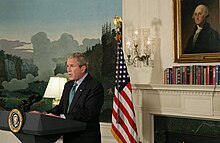This article needs to be updated. (June 2018) |
 | |
| Long title | A bill to provide authority for the Federal Government to purchase and insure certain types of troubled assets for the purposes of providing stability to and preventing disruption in the economy and financial system and protecting taxpayers, to amend the Internal Revenue Code of 1986 to provide incentives for energy production and conservation, to extend certain expiring provisions, to provide individual income tax relief, and for other purposes. |
|---|---|
| Enacted by | the 110th United States Congress |
| Citations | |
| Public law | Pub. L. 110–343 (text) (PDF) |
| Legislative history | |
| |

Public Law 110-343 (Pub. L. 110–343 (text) (PDF), 122 Stat. 3765, enacted October 3, 2008) is a US Act of Congress signed into law by U.S. President George W. Bush, which was designed to mitigate the growing financial crisis of the late-2000s by giving relief to so-called "Troubled Assets."[1][2]
Its formal title is "An Act To provide authority for the Federal Government to purchase and insure certain types of troubled assets for the purposes of providing stability to and preventing disruption in the economy and financial system and protecting taxpayers, to amend the Internal Revenue Code of 1986 to provide incentives for energy production and conservation, to extend certain expiring provisions, to provide individual income tax relief, and for other purposes."
The Act created a $700 billion (~$973 billion in 2023) Troubled Asset Relief Program under the Emergency Economic Stabilization Act of 2008 (division A), and also enacted the Energy Improvement and Extension Act of 2008 (division B), Tax Extenders and Alternative Minimum Tax Relief Act of 2008 (division C), which also included the Paul Wellstone and Pete Domenici Mental Health Parity and Addiction Equity Act of 2008, and the Heartland Disaster Tax Relief Act of 2008.[3][4]
- ^ President Bush Signs H.R. 1424 Into Law, White House Press Release, October 3, 2008.
- ^ "Renewable Energy Tax Credits Extended as Far as 2016 (Energy Priorities Archives)". energypriorities.com. Retrieved 9 September 2018.
- ^ Cite error: The named reference
LOC-THOMAS-HR1424was invoked but never defined (see the help page). - ^ Pub. L. 110–343 (text) (PDF)